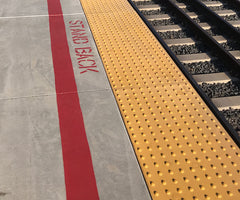 To most of us, they are "those bumpy yellow thingys" at corners, and along train station platforms, or in front of Costco. But inside the world of the Americans with Disabilities Act (ADA), they are called truncated domes, tactile warning systems, or detectable warning tiles, or tactile pavement.
To most of us, they are "those bumpy yellow thingys" at corners, and along train station platforms, or in front of Costco. But inside the world of the Americans with Disabilities Act (ADA), they are called truncated domes, tactile warning systems, or detectable warning tiles, or tactile pavement.
But where did they come from? And why? And while we're at it, who invented truncated domes?
Strap yourself into your handy Time Machine. Set the time to 1965, and the place to Japan.
Tactile blocks, or tenji blocks as they were originally known, were designed by Seiichi Miyake in 1965.
The design was inspired by a friend of his who was slowly going blind, and were first installed in 1967 along a highway near the Okayama School for the Blind.
The bumpy surface is not, as many people think, for traction. It is actually designed to warn the blind of upcoming dangers, such as a curb that drops off into the street.
Seiichi Miyake wanted to help people with visual impairments travel safely through streets. He was also worried that people who could not see well were in danger when boarding a train. In the 1970s, all Japan Railway platforms were modified to include tactile warning surfaces, which were in two distinct patterns.
The first pattern was a series of lines to communicate to the sight-impaired or blind that they were traveling along a pedestrian path and could continue moving forward. The second pattern consisted of truncated domes, which communicated to that person (through their use of a cane tapping on them, or their bumpy surface under their shoes) that they should stop -- because of a change in direction or a transition from sidewalk to street, or that they were reaching the end of the train platform and should stop there, to wait for the train to arrive before proceeding.

After the United Stated enacted the ADA (Americans with Disabilities Act), truncated domes were used on sidewalks, train stations, and on public thoroughfares that cross motorized traffic areas. ADA truncated domes do not use the lined tiles to mean "Go", as they did in Japan. In the U.S., only the truncated domes which mean "Stop" are used.
Miyake's tactile blocks, and the many variants of them used in dozens of countries throughout the world, guide people (both with and without physical impairments), safely and easily along platforms, footpaths, through concourses, in and out of buildings - they're even used in parks.
Note: On March 18 2019 the Google Doodle honored Seiichi Miyake and his invention of truncated domes!

